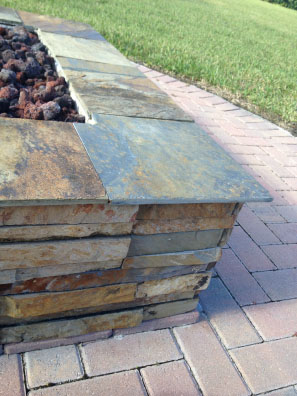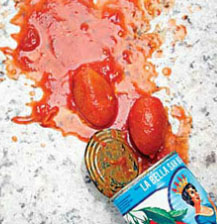Slate Tile - a Natural Stone Alternative to Ceramic Tile
 Slate is a generalized term in the natural stone industry, and can take on a whole lot of different meanings depending on who you talk to. Many people refer to any naturally cleft stone in the grey - brown color family, be it for flooring or wall cladding, as slate. Norstone’s Charcoal and Ochre Blend Rock Panels are often confused for slate, although neither of them actually contain slate, which is a dense, but soft, fine grained metamorphic rock. Slate itself can vary in terms of its physical properties depending on what quarrying region it comes from, which includes both North and South America, and Asia. Although wildly popular for both interior and exterior uses, slate does have its limitations, including certain varieties that tend to be softer, thus more susceptible to scratching and flaking / powdering with use, as well as other varieties which have high absorption rates and shouldn’t be used for exterior applications in freeze / thaw climates. Always work with a knowledgeable stone expert when buying slate and discuss what you plan to use it for to make sure the type of slate you’re buying is a good match for the job. Once installed, there are a few easy tips to remember when maintaining slate tile and other natural stone tile products.
Slate is a generalized term in the natural stone industry, and can take on a whole lot of different meanings depending on who you talk to. Many people refer to any naturally cleft stone in the grey - brown color family, be it for flooring or wall cladding, as slate. Norstone’s Charcoal and Ochre Blend Rock Panels are often confused for slate, although neither of them actually contain slate, which is a dense, but soft, fine grained metamorphic rock. Slate itself can vary in terms of its physical properties depending on what quarrying region it comes from, which includes both North and South America, and Asia. Although wildly popular for both interior and exterior uses, slate does have its limitations, including certain varieties that tend to be softer, thus more susceptible to scratching and flaking / powdering with use, as well as other varieties which have high absorption rates and shouldn’t be used for exterior applications in freeze / thaw climates. Always work with a knowledgeable stone expert when buying slate and discuss what you plan to use it for to make sure the type of slate you’re buying is a good match for the job. Once installed, there are a few easy tips to remember when maintaining slate tile and other natural stone tile products.
The first thing any natural stone owner or caretaker should do is consider sealing their stone. Water based sealers are going to be recommended for most slate tiles and other natural stone materials and not only afford the stone a layer of protection against the elements, but can also be used to achieve certain looks, including high gloss or “wet look” finishes. It’s important to test any natural stone sealer on a sample piece, off cut, or in an inconspicuous place on the installation to verify the results before applying the sealer over the entire application. Sealing will provide your slate tile or other natural stone tiles with the best pro-active protection available. The photo below shows the difference between unsealed slate tile and tiles that have been sealed with a color enhancing sealer. 
 When the inevitable call for clean up does occur, be it a spilled glass of wine or junior dropping his bowl of spaghetti off his high-chair, the first and most important step is to take action as quickly as possible. Slate Tiles and most other natural stone tiles are porous and will soak up liquid spills. Immediately triage by wiping up the spill with a paper towel and then use either a detergent based cleaner or a specially formulated natural stone cleaner to tackle deep staining. Remember that slate tiles, depending on their origin, can be soft, so clean using a plastic bristle brush to avoid any surface scratching and most importantly do not use any acidic cleaners, including citrus based products, or scouring products which can cause damage to the stone. It’s always going to be a good idea to reseal an area that just underwent a thorough cleaning as the cleaning likely removed or greatly decreased the efficacy of the sealer.
When the inevitable call for clean up does occur, be it a spilled glass of wine or junior dropping his bowl of spaghetti off his high-chair, the first and most important step is to take action as quickly as possible. Slate Tiles and most other natural stone tiles are porous and will soak up liquid spills. Immediately triage by wiping up the spill with a paper towel and then use either a detergent based cleaner or a specially formulated natural stone cleaner to tackle deep staining. Remember that slate tiles, depending on their origin, can be soft, so clean using a plastic bristle brush to avoid any surface scratching and most importantly do not use any acidic cleaners, including citrus based products, or scouring products which can cause damage to the stone. It’s always going to be a good idea to reseal an area that just underwent a thorough cleaning as the cleaning likely removed or greatly decreased the efficacy of the sealer.
We expect slate tile and other natural stone tile products to continue to be sought after for the unique one of a kind natural look that can’t be re-created in a factory. With a few simple steps and knowledge of how to care for these types of products, slate and other natural stone floor and wall coverings not only make sense but become very appealing to the discerning customer looking to set their project apart. So go ahead and use a natural stone tile for your next project - you’ll thank us later!
.png)




